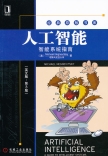 [内容简介]人工智能经常被人们认为是计算机科学中一门高度复杂甚至令人生畏的学科。长期以来人工智能方面的书籍往往包含复杂矩阵代数和微分方程。本书基于作者多年来给没有多少微积分知识的学生授课时所用的讲义。假定读者没有编程经验,以简单易懂的方式介绍了智能系统的基础知识。尼格尼维斯基编著的《人工智能》目前已经被国际上多所大学(例如,德国的马格德堡大学、日本的广岛大学、美国的波士顿大学和罗切斯特理工学院等)采纳为教材。如果您正在寻找关于人工智能或智能系统设计课程的浅显易懂的入门级教材,如果您不是计算机科学领域的专业人员而又正在寻找介绍基于知识系统最新技术发展的自学指南,本书将是您的最佳选择。与上一版相比,本版进行了全面更新,以反映人工智能领域的最新进展。其中新增了数据挖掘与知识发现一章和自组织神经网络聚类一节内容。同时补充了4个新的案例研究。
[内容简介]人工智能经常被人们认为是计算机科学中一门高度复杂甚至令人生畏的学科。长期以来人工智能方面的书籍往往包含复杂矩阵代数和微分方程。本书基于作者多年来给没有多少微积分知识的学生授课时所用的讲义。假定读者没有编程经验,以简单易懂的方式介绍了智能系统的基础知识。尼格尼维斯基编著的《人工智能》目前已经被国际上多所大学(例如,德国的马格德堡大学、日本的广岛大学、美国的波士顿大学和罗切斯特理工学院等)采纳为教材。如果您正在寻找关于人工智能或智能系统设计课程的浅显易懂的入门级教材,如果您不是计算机科学领域的专业人员而又正在寻找介绍基于知识系统最新技术发展的自学指南,本书将是您的最佳选择。与上一版相比,本版进行了全面更新,以反映人工智能领域的最新进展。其中新增了数据挖掘与知识发现一章和自组织神经网络聚类一节内容。同时补充了4个新的案例研究。
[目次]1 Introduction to knowledge-based intelligent systems
1.1 Intelligent machines, or what machines can do
1.2 The history of artificial intelligence, or from the Dark
Ages to knowledge-based systems
1.3 Summary
Questions for review
References
2 Rule-based expert systems
2.1 Introduction, or what is knowledge?
2.2 Rules as a knowledge representation technique
2.3 The main players in the expert system development team
2.4 Structure of a rule-based expert system
2.5 Fundamental characteristics of an expert system
2.6 Forward chaining and backward chaining inference techniques
2.7 MEDIA ADVISOR: a demonstration rule-based expert system
2.8 Conflict resolution
2.9 Advantages and disadvantages of rule-based expert systems
2.10 Summary
Questions for review
References
3 Uncertainty management in rule-based expert systems
3.1 Introduction, or what is uncertainty?
3.2 Basic probability theory
3.3 Bayesian reasoning
3.4 FORECAST: Bayesian accumulation of evidence
3.5 Bias of the Bayesian method
3.6 Certainty factors theory and evidential reasoning
3.7 FORECAST: an application of certainty factors
3.8 Comparison of Bayesian reasoning and certainty factors
3.9 Summary
Questions for review
References
4 Fuzzy expert systems
4.1 Introduction, or what is fuzzy thinking?
4.2 Fuzzy sets
4.3 Linguistic variables and hedges
4.4 Operations of fuzzy sets
4.5 Fuzzy rules
4.6 Fuzzy inference
4.7 Building a fuzzy expert system
4.8 Summary
Questions for review
References
Bibliography
5 Frame-based expert systems
5.1 Introduction, or what is a frame?
5.2 Frames as a knowledge representation technique
5.3 Inheritance in frame-based systems
5.4 Methods and demons
5.5 Interaction of frames and rules
5.6 Buy Smart: a frame-based expert system
5.7 Summary
Questions for review
References
Bibliography
6 Artificial neural networks
6.1 Introduction, or how the brain works
6.2 The neuron as a simple computing element
6.3 The perceptron
6.4 Multilayer neural networks
6.5 Accelerated learning in multilayer neural networks
6.6 The Hopfield network
6.7 Bidirectional associative memory
6.8 Self-organising neural networks
6.9 Summary
Questions for review
References
7 Evolutionary computation
7.1 Introduction, or can evolution be intelligent?
7.2 Simulation of natural evolution
7.3 Genetic algorithms
7.4 Why genetic algorithms work
7.5 Case study: maintenance scheduling with genetic algorithms
7.6 Evolution strategies
7.7 Genetic programming
7.8 Summary
Questions for review
References
Bibliography
8 Hybrid intelligent systems
8.1 Introduction, or how to combine German mechanics with
Italian love
8.2 Neural expert systems
8.3 Neuro-fuzzy systems
8.4 ANFIS: Adaptive Neuro-Fuzzy Inference System
8.5 Evolutionary neural networks
8.6 Fuzzy evolutionary systems
8.7 Summary
Questions for review
References
9 Knowledge engineering
9.1 Introduction, or what is knowledge engineering?
9.2 Will an expert system work for my problem?
9.3 Will a fuzzy expert system work for my problem?
9.4 Will a neural network work for my problem?
9.5 Will genetic algorithms work for my problem?
9.6 Will a hybrid intelligent system work for my problem?
9.7 Summary
Questions for review
References
10 Data mining and knowledge discovery
10.1 Introduction, or what is data mining?
10.2 Statistical methods and data visualisation
10.3 Principal component analysis
10.4 Relational databases and database queries
10.5 The data warehouse and multidimensional data analysis
10.6 Decision trees
10.7 Association rules and market basket analysis
10.8 Summary
Questions for review
References
Glossary
Appendix: AI tools and vendors
index

 新书报道
新书报道